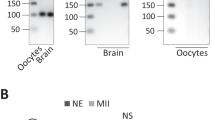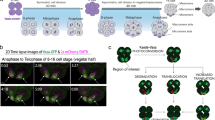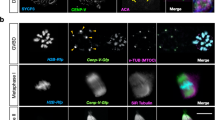Abstract
Meiotic progression requires the translational activation of stored maternal mRNAs, such as those encoding cyclin B1 or mos. The translation of these mRNAs is regulated by the cytoplasmic polyadenylation element (CPE) present in their 3′UTRs, which recruits the CPE-binding protein CPEB1. This RNA-binding protein not only dictates the timing and extent of translational activation by cytoplasmic polyadenylation2,3 but also participates, together with the translational repressor Maskin, in the transport and localization, in a quiescent state, of its targets to subcellular locations where their translation will take place4. During the early development of Xenopus laevis, CPEB localizes at the animal pole of oocytes and later on at embryonic spindles and centrosomes5. Disruption of embryonic CPEB-mediated translational regulation results in abnormalities in the mitotic apparatus and inhibits embryonic mitosis5. Here we show that spindle-localized translational activation of CPE-regulated mRNAs, encoding for proteins with a known function in spindle assembly and chromosome segregation, is essential for completion of the first meiotic division and for chromosome segregation in Xenopus oocytes.
This is a preview of subscription content, access via your institution
Access options
Subscribe to this journal
Receive 12 print issues and online access
$209.00 per year
only $17.42 per issue
Buy this article
- Purchase on Springer Link
- Instant access to full article PDF
Prices may be subject to local taxes which are calculated during checkout





Similar content being viewed by others
Accession codes
References
Richter, J. D. CPEB: a life in translation. Trends Biochem. Sci. 32, 279–285 (2007).
Mendez, R. et al. Phosphorylation of CPE binding factor by Eg2 regulates translation of c-mos mRNA. Nature 404, 302–307 (2000).
Mendez, R., Barnard, D. & Richter, J. D. Differential mRNA translation and meiotic progression require Cdc2-mediated CPEB destruction. EMBO J. 21, 1833–1844 (2002).
Huang, Y. S., Carson, J. H., Barbarese, E. & Richter, J. D. Facilitation of dendritic mRNA transport by CPEB. Genes Dev. 17, 638–53 (2003).
Groisman, I. et al. CPEB, maskin, and cyclin B1 mRNA at the mitotic apparatus: implications for local translational control of cell division. Cell 103, 435–447 (2000).
Barnard, D. C., Cao, Q. & Richter, J. D. Differential phosphorylation controls Maskin association with eukaryotic translation initiation factor 4E and localization on the mitotic apparatus. Mol. Cell Biol. 25, 7605–7615 (2005).
O'Brien, L. L. et al. The Xenopus TACC homologue, maskin, functions in mitotic spindle assembly. Mol. Biol. Cell 16, 2836–2847 (2005).
Peset, I. et al. Function and regulation of Maskin, a TACC family protein, in microtubule growth during mitosis. J. Cell Biol. 170, 1057–1066 (2005).
Blower, M. D., Nachury, M., Heald, R. & Weis, K. A Rae1-containing ribonucleoprotein complex is required for mitotic spindle assembly. Cell 121, 223–234 (2005).
Lambert, J. D. & Nagy, L. M. Asymmetric inheritance of centrosomally localized mRNAs during embryonic cleavages. Nature 420, 682–686 (2002).
Alliegro, M. C., Alliegro, M. A. & Palazzo, R. E. Centrosome-associated RNA in surf clam oocytes. Proc. Natl Acad. Sci. USA 103, 9034–9038 (2006).
Liska, A. J. et al. Homology-based functional proteomics by mass spectrometry: application to the Xenopus microtubule-associated proteome. Proteomics 4, 2707–2721 (2004).
Blower, M. D., Feric, E., Weis, K. & Heald, R. Genome-wide analysis demonstrates conserved localization of messenger RNAs to mitotic microtubules. J. Cell Biol. 179, 1365–1373 (2007).
Pique, M., Lopez, J. M., Foissac, S., Guigo, R. & Mendez, R. A combinatorial code for CPE-mediated translational control. Cell 132, 434–448 (2008).
Antonio, C. et al. Xkid, a chromokinesin required for chromosome alignment on the metaphase plate. Cell 102, 425–435 (2000).
Perez, L. H., Antonio, C., Flament, S., Vernos, I. & Nebreda, A. R. Xkid chromokinesin is required for the meiosis I to meiosis II transition in Xenopus laevis oocytes. Nature Cell Biol. 4, 737–742 (2002).
Gruss, O. J. & Vernos, I. The mechanism of spindle assembly: functions of Ran and its target TPX2. J. Cell Biol. 166, 949–955 (2004).
Bertrand, E. et al. Localization of ASH1 mRNA particles in living yeast. Mol. Cell 2, 437–445 (1998).
de Moor, C. H. & Richter, J. D. Cytoplasmic polyadenylation elements mediate masking and unmasking of cyclin B1 mRNA. EMBO J. 18, 2294–2303 (1999).
Iwabuchi, M., Ohsumi, K., Yamamoto, T. M., Sawada, W. & Kishimoto, T. Residual Cdc2 activity remaining at meiosis I exit is essential for meiotic M–M transition in Xenopus oocyte extracts. EMBO J. 19, 4513–4523 (2000).
Zhou, B. B., Li, H., Yuan, J. & Kirschner, M. W. Caspase-dependent activation of cyclin-dependent kinases during Fas-induced apoptosis in Jurkat cells. Proc. Natl Acad. Sci. USA 95, 6785–6790 (1998).
Wittmann, T., Wilm, M., Karsenti, E. & Vernos, I. TPX2, A novel Xenopus MAP involved in spindle pole organization. J. Cell Biol. 149, 1405–1418 (2000).
Charlesworth, A., Ridge, J. A., King, L. A., MacNicol, M. C. & MacNicol, A. M. A novel regulatory element determines the timing of Mos mRNA translation during Xenopus oocyte maturation. EMBO J. 21, 2798–2806 (2002).
Murray, A. W. in Xenopus laevis: practical uses in cell on molecular biology (eds Kay, B. K. & Peng, H. B.) 581–605 (Academic Press, San Diego, 1991).
Becker, B. E. & Gard, D. L. Visualization of the cytoskeleton in Xenopus oocytes and eggs by confocal immunofluorescence microscopy. Methods Mol. Biol. 322, 69–86 (2006).
Wormington, M. Preparation of synthetic mRNAs and analyses of translational efficiency in microinjected Xenopus oocytes. Methods Cell Biol. 36, 167–183 (1991).
Acknowledgements
We thank Joel D. Richter for the anti-CPEB antibody, Angel Nebreda for Xkid cDNA and antibody, Edouard Bertrand and Robert H. Singer for MS2-binding sites and MS2–GFP cDNAs, Fátima Gebauer for the reporter plasmids pLuccassette and pRenilla and her helpful discussions, CRG-Microscopy Facility for technical advice and Mercedes Fernández, members of the Méndez laboratory, Juan Valcarcel and other colleagues from the Program of Gene Expression for helpful advice and critically reading the manuscript. This work was supported by grants from the MEC, Fundación 'La Caixa' and Fundació 'Marató de TV3'. R.M. is a recipient of a contract from the 'Programa Ramon y Cajal' (MEC). CE is recipient of a fellowship from the DURSI (Generalitat de Catalunya) i dels Fons Social Europeu.
Author information
Authors and Affiliations
Contributions
I.P. performed the experiments shown in Fig. 2c, d and f; C.E. performed the rest of the experiments; I.V. and R.M. contributed to the experimental design and prepared the manuscript.
Corresponding author
Ethics declarations
Competing interests
The authors declare no competing financial interests.
Supplementary information
Supplementary Information
Supplementary Figures S1, S2, S3, S4, S5, S6 (PDF 1376 kb)
Rights and permissions
About this article
Cite this article
Eliscovich, C., Peset, I., Vernos, I. et al. Spindle-localized CPE-mediated translation controls meiotic chromosome segregation. Nat Cell Biol 10, 858–865 (2008). https://doi.org/10.1038/ncb1746
Received:
Accepted:
Published:
Issue Date:
DOI: https://doi.org/10.1038/ncb1746
This article is cited by
-
Unconventional roles of chromatin remodelers and long non-coding RNAs in cell division
Cellular and Molecular Life Sciences (2023)
-
Vasa nucleates asymmetric translation along the mitotic spindle during unequal cell divisions
Nature Communications (2022)
-
Musashi 1 regulates the timing and extent of meiotic mRNA translational activation by promoting the use of specific CPEs
Nature Structural & Molecular Biology (2017)
-
BTG4 is a meiotic cell cycle–coupled maternal-zygotic-transition licensing factor in oocytes
Nature Structural & Molecular Biology (2016)
-
CPEB1 mediates epithelial-to-mesenchyme transition and breast cancer metastasis
Oncogene (2016)



